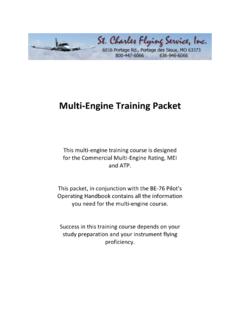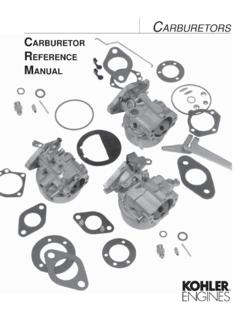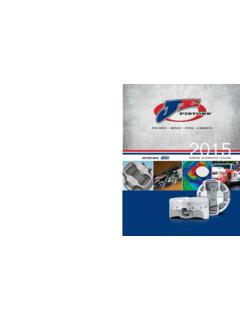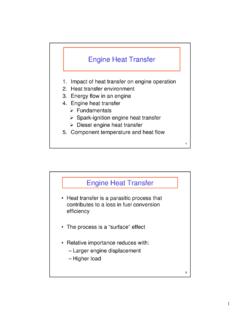Transcription of An Engineering Guide to Modern ... - Critical Fuel Systems
1 An Engineering Guide to Modern Fuel Systems This publication is intended as a resource for designers, installers, and system operators. In this document we highlight the typical indoor components and operational requirements of Modern diesel fuel or fuel oil Systems . Critical Fuel Systems , division of BFS Industries, LLC 200 Industrial Drive, Butner, NC 27509, (919)575-6711 Table of Contents A Guide to Modern Fuel Systems Copyright 2012, Critical Fuel Systems , div of BFS Industries, LLC Introduction .. 2 Heated returns from generators .. 3 Generator pump sizing and selection .. 5 Boiler system pump sizing and selection .. 6 Pump Types .. 8 Building fuel piping and fittings ..12 Day tank sizing and selection ..13 Care and storage of diesel fuel ..17 Controls, monitoring and communications ..20 Engineering data, generator equipment sizing ..22 Engineering data, boiler equipment sizing ..23 Engineering data, routine maintenance ..24 1 Introduction The focus of this Guide is diesel fuel Systems for emergency generators and other applications that require long term storage of diesel fuel (or fuel oil).
2 We will discuss the portion of the fuel system that is found in the building. Storage tanks and buried piping will not be addressed. Description of a Modern diesel fuel system as a standby energy source. The Modern diesel fuel or fuel oil Systems are used differently than Systems designed a decade or more ago. In early fuel oil system designs, boilers were the primary user of the fuel. The fuel oil was a primary energy source used consistently throughout the year. With the advent of natural gas, the liquid fuels were replaced throughout most of the country as a primary energy source and rele-gated to stand-by status. Natural gas Systems in their early life were unreliable and insufficient for use throughout the entire year. The operators of large natural gas equipment would be required, usually during cold weather, to shift from burning natural gas to burning fuel oil. Systems designed during that time were sized with the intent that the fuel would be turned over several times throughout the year.
3 Today, the natural gas infrastructure is very reliable, if boilers do have a back up fuel oil system, they may operate on oil for brief periods each year, never consuming much fuel. On emergency generator Systems , the fuel usage is typically no different. In both of these cases, the stored fuel may sit in the storage tanks for years at a time and will require special treatment to insure reliable operation when needed. In this Guide we specifically address several issues unique to diesel fuel Systems supporting emer-gency generators. Many of the same issues will apply to boilers where very small amounts of oil are burned each year. Diesel Fuel Properties Besides providing chemical energy for the boiler or generator to convert, diesel fuel serves as a lu-bricant for the pumps and lubrication/cooling for the injectors of engine generators. When not maintained the fuel will degrade rapidly beyond the point of usability, especially for generator sys-tems. The degradation process is accelerated by; moisture, heat, oxygen, and biological growth.
4 Diesel fuel or #2 fuel oil is hydrophilic, it will attract moisture. Some of the moisture will settle out of the fuel to become free water. Removing the moisture and free water is key to maintaining the fuel. 2 Heated returns from generators The diesel engines that powers Modern generators are built with an integral onboard fuel pump. This pump will draw fuel from the day tank or fuel supply header and deliver it to the fuel injectors at the correct pressure. This pump moves more fuel than the generator will consume at any given load. The unused fuel is circulated through several components as a means of cooling them under varying loads. By design this unused fuel absorbs heat and, in most cases, this heated fuel is re-turned to the day tank The temperature differential between the generator pump inlet and return to day tank may be less than 15 F. Though the initial rise in day tank temperatures is modest, the effects are cumulative and under certain load conditions the day tank temperature may approach Critical levels.
5 One conse-quence of the fuel heating up is that at a certain point the generator output will decline. A good rule of thumb is a 1% decrease in output per 10 F rise in fuel temperature above 100 F. Another con-sideration is that most generators now employ high fuel temperature cutouts, these switches typi-cally activate, shutting down the generator at a fuel inlet temperature of around 150 - 160 F. Since diesel fuel can have a flashpoint near 140 F, it is advisable to never let the fuel get this warm. Besides producing potentially explosive vapors, its stability can be so damaged the diesel fuel loses most of its lubricating properties. The fuel management and monitoring Systems should maintain the fuel temperature below 130 F. Here are a few options available to designers to control diesel fuel temperatures in the system: Option A On board fuel cooler Most large generator manufacturers provide an option to add a fuel cooler. This may be a section in the engines radiator or a separate on-board fuel cooler with its own fan.
6 This is usually preferable when available. Option B Day tank fuel replacement Specify a day tank temperature control option. This type of system is fairly simple, monitor the tank temperature, when it reaches a predetermined point, pump most of the fuel back to the storage tank and refill with relatively cool fuel from the storage tank. One advantage of this approach is that every time you replenish the tank, the pumping and control system is checked for proper operation. 3 Option C External fuel cooler External fuel coolers are typically used in situations where the cooler was not in-cluded in the initial design. These Systems offer a cost effective retrofit provided there is enough physical space in the equipment room or adjacent outdoor area to ac-commodate the extra equipment. One limitation that must be accounted for with these arrangements is the ability of the generator s fuel pump to return the fuel. Any head pressure caused by piping layout or pressure drop through the cooler must be within the tolerances specified by the engine manufacturer.
7 Option D Piped return to storage tank An option that can work only under a few specific circumstances is returning the heated fuel back to the storage tank instead of the day tank. This arrangement re-quires the pump set to be sized to accommodate the added flow of fuel, including the fuel not being consumed by the engine . It would also require a much larger day tank to accommodate the same run time requirements. 4 Generator Pump Sizing Pump sizing is typically straightforward. Calculate the total generator load, convert KWH to GPH fuel consumption then multiply by 4 to determine pump size. The factor of 4 is typical with the goal to provide a 15 minute fill cycle at full load for the pumps. This factor can be altered, especially in multi day tank applications as long as the designer is accounting for all of the variables. The following table was developed to assist in sizing the transfer pumps for a generator fuel system. This table is not designed to replace proper Engineering calculations in final system design.
8 The fuel consumption is based on the rule of thumb that it takes about 7 gallons of #2 diesel fuel per hour to generate 100KW electrical power in a single generator. 5 Boiler Systems Pump Selection Typical Modern boilers will fire natural gas as the primary fuel, with a percentage of these using #2 fuel oil as a backup fuel. A system designer should be aware of a couple of key points when in-volved with boiler fuel oil Systems . 1) Most boilers firing fuel oil will have their own fuel oil pump. 2) This pump can typically handle a low suction pressure of 15 Hg without difficulty but a high suc-tion pressure of over 3 psig can cause the failure of the pumps seals. This high pressure can be caused by a fuel transfer pump or the static head caused by an elevated (relative to boiler pump) supply system. Low Suction Pressure Limit 15 Hg High Suction Pressure Limit 3 psig Simplifying the fuel system , reducing capital and operational costs is simple, the fuel Systems for Modern boilers have evolved in a way that more than 80% of new boilers that burn fuel oil are pro-vided with their own on-board fuel oil pumps.
9 If the onboard pumps have the ability to pump di-rectly from the single storage tank this may be a very practical and efficient arrangement. In most Systems this is not typical and a transfer pump is needed to pump oil out of the storage tank(s) and deliver to the boiler mounted pumps at a very low pressure. This transfer pump must be over sized by a factor of to accommodate the extra flow required by the onboard pumps. Always check the flow of the fuel pump supplied by the manufacturer. On some boilers there can be a 5 to 10 times factor for the pump size compared with the burn rate. A simple solution is to do away with the boiler s onboard pumps and increase the supply pressure from the transfer pumps. This arrangement will eliminate the cost and electrical load of the boiler mounted pumps, reduce the electrical load of the transfer pump as well as reduce the required pipe sizing. The only cost adder may be a pressure regulator on the fuel sup-ply pipe to each boiler.
10 This cost is usually offset by the elimination of the burner pump and removes the single point of failure that the burner mounted pump introduces. This table was developed to assist in sizing the transfer pumps for a boiler fuel oil system. This table is not designed to replace proper Engineering calculations in final system de-sign. The fuel consumption is based on a typical firetube boiler firing 140,000btu/g #2 fuel oil. 6 This arrangement will work fine, in most cases, as long as the pump suction does not exceed 15 Hg. This arrangement is not recom-mended for multiple storage tanks. When the suction pressure is too much for the boiler mounted pumps or when multiple storage tanks are required this has been the traditional arrangement. By eliminating the boiler mounted pumps the overall electrical load and equipment cost can be reduced. Boiler Systems Pump Selection 7 Pump Types Suction pumps or pressure (submersible) pumps? Choosing between a submersible pump and a suction type pump set is fairly easy.







